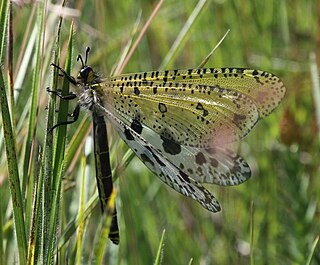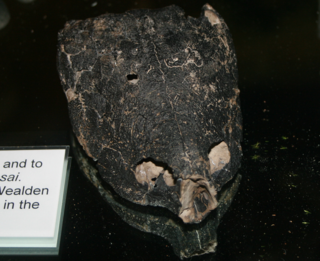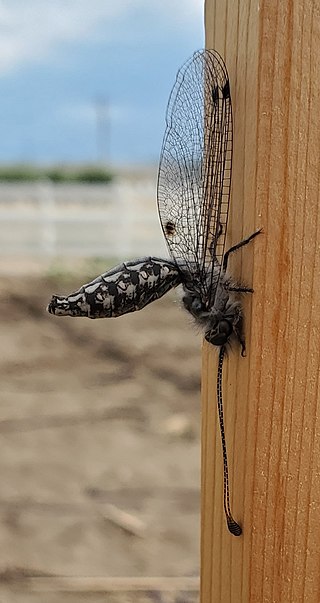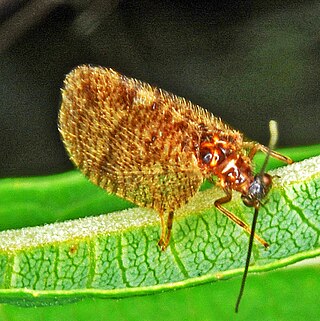
The antlions are a group of about 2,000 species of insect in the neuropteran family Myrmeleontidae. They are known for the predatory habits of their larvae, which mostly dig pits to trap passing ants or other prey. In North America, the larvae are sometimes referred to as doodlebugs because of the marks they leave in the sand. The adult insects are less well known due to their relatively short lifespans in comparison with the larvae. Adults, sometimes known as antlion lacewings, mostly fly at dusk or just after dark and may be mistakenly identified as dragonflies or damselflies.

Ascalaphidae is a family of insects in the order Neuroptera, commonly called owlflies; there are some 450 extant species. They are fast-flying crepuscular or diurnal predators of other flying insects, and have large bulging eyes and strongly knobbed antennae. The larvae are ambush predators; some of them make use of self-decoration camouflage.

Neurobasis is a genus of damselflies belonging to the family Calopterygidae. They are found from India, through south-east Asia, Indonesia and New Guinea.

Chrysoperla is a genus of common green lacewings in the neuropteran family Chrysopidae. Therein they belong to the Chrysopini, the largest tribe of subfamily Chrysopinae. Their larvae are predatory and feed on aphids, and members of this genus have been used in biological pest control.

Composita is an extinct brachiopod genus that lived from the Late Devonian to the Late Permian. Composita had a cosmopolitan global distribution, having lived on every continent except Antarctica. Composita had a smooth shell with a more or less distinct fold and sulcus and a round opening for the pedicle on the pedicle valve. Composita is included in the family Athyrididae and placed in the subfamily Spirigerellinae.

Teleopsis is a genus of stalk-eyed flies in the family Diopsidae. All species in the genus are found in Asia. About 20 species are described and several others as yet are to be described.

Palpares caffer is a species of antlions in the family Myrmeleontidae, which is native to southern Africa. It was described by Hermann Burmeister in 1839.

Sympherobius is a genus of brown lacewings in the family Hemerobiidae. There are at least 50 described species in Sympherobius.

Helochelydra is an extinct genus of extinct stem turtle known from the Early Cretaceous (Barremian) of the Isle of Wight, southern England.

Ululodes is a genus of owlflies in the tribe Ululodini. There are at least 27 described species in Ululodes.

Glenurus is a genus of antlions in the family Myrmeleontidae and typical of the tribe Glenurini. There are about 12 described species in Glenurus.

Micropeplus is a genus of rove beetles in the family Staphylinidae. There are at least 40 described species in Micropeplus.

Brachynemurus is a genus of antlions in the family Myrmeleontidae. There are at least 20 described species in Brachynemurus.

Dendroleon is a genus of antlions in the family Myrmeleontidae. There are more than 20 described species in Dendroleon.

Megalomus is a genus of brown lacewings in the family Hemerobiidae. There are more than 40 described species in Megalomus.

Apertochrysa is a genus of green lacewings in the family Chrysopidae. There are 183 described species in the genus.
Indoleon is a genus of antlions belonging to the family Myrmeleontidae.

Heoclisis is a genus of cave-dwelling antlions, that is, insects in the family Myrmeleontidae.

Protohermes is a genus of dobsonflies in the family Corydalidae. Protohermes is the most speciose and widely distributed genus within Megaloptera, but up to 85% of species are restricted to small endemic areas in Asia. This endemism may be a result of an association with high elevation and high slope streams in Northern Vietnam and China.


















